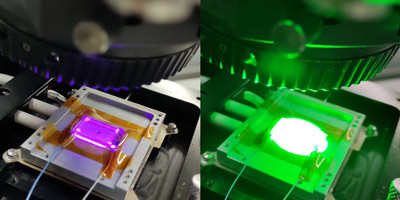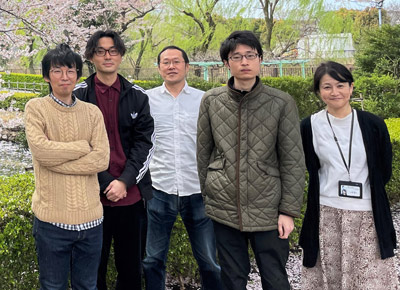Jun. 3, 2022 Research Highlight Chemistry
Shining light on a fluid completely changes its dielectric permittivity
Simply illuminating a fluid can cause its interaction with an electric field to greatly vary
 Figure 1: Figure 1: Shining blue light (left) on the fluid caused it to switch to a high dielectric permittivity phase, while shining green light on it (right) reversed the change. Reproduced from Ref. 1 and licensed under CC BY 4.0 © 2020 H. Nishikawa et al.
Figure 1: Figure 1: Shining blue light (left) on the fluid caused it to switch to a high dielectric permittivity phase, while shining green light on it (right) reversed the change. Reproduced from Ref. 1 and licensed under CC BY 4.0 © 2020 H. Nishikawa et al.
Three RIKEN researchers have created a liquid whose response to an electric field can be tuned over the largest range of any known material1. The fluid could find use in various applications including wearable electronics.
How materials respond to an electric field varies widely. Some ceramics, plastics and glasses show large responses because they are made of polar molecules, which have positive and negative parts. When an electric field is applied, the molecules align themselves with the electric field. In contrast, an electric field has very little effect on materials that have non-polar molecules such as air and most organic materials.
This response is measured by a number known as the dielectric permittivity—air has a dielectric permittivity very close to one, whereas materials with large responses have values in the thousands.
Now, Hiroya Nishikawa, Koki Sano and Fumito Araoka, all at the RIKEN Center for Emergent Matter Science, have developed a liquid whose dielectric permittivity can range from 200 to 18,000 in just half a minute when light is shone on it.
The trio realized this by combining two molecules. The first molecule is a liquid crystal that has two phases: one with a low dielectric permittivity and the other with an extremely high one. The second molecule is light sensitive. When blue light was shone on the combined molecule, it switched from the low-dielectric-permittivity phase to the high one; when green light was shone on the fluid it reversed the situation, causing it to return to the low-dielectric-permittivity phase (Fig. 1).
 Hiroya Nishikawa (left) and Fumito Araoka (third from left) and Koki Sano (not shown) have demonstrated an anisotropic fluid with a photoresponsive dielectric permittivity. © 2022 RIKEN
Hiroya Nishikawa (left) and Fumito Araoka (third from left) and Koki Sano (not shown) have demonstrated an anisotropic fluid with a photoresponsive dielectric permittivity. © 2022 RIKEN
Since a high dielectric permittivity is important for creating capacitors that store a lot of electric charge, the fluid could be used in applications that require variable capacitors. “If you wanted to get such a high capacitance, you would need a specially designed capacitor,” says Araoka. “But we could realize a high capacitance by just sandwiching the material between electrodes because the fluid has such a high dielectric permittivity.”
The team demonstrated an application of the fluid by coupling it with a sound generator and using it to change the sound’s pitch over a wide range when they shone light on the fluid.
The mechanism behind the high dielectric permittivity is a mystery. “We currently have no idea how this high dielectric permittivity is realized,” says Araoka. “So we’d like to discover the reason for it.”
The team also wants to use the fluid to create flexible electronic devices. “In the current study, we used a glass substrate,” says Nishikawa. “But we can replace it with a flexible film to create devices that can be worn on the skin.”
Related contents
- A shapeshifting material based on inorganic matter
- Creating coherent motion based on coordinated microscopic movements
- Physicists uncover the topological origin of surface electromagnetic waves
Rate this article
Reference
- 1. Nishikawa, H., Sano, K. & Araoka, F. Anisotropic fluid with phototunable dielectric permittivity. Nature Communications 13, 1142 (2022). doi: 10.1038/s41467-022-28763-1
